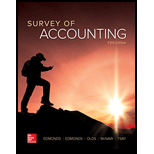
Survey Of Accounting
5th Edition
ISBN: 9781259631122
Author: Edmonds, Thomas P.
Publisher: Mcgraw-hill Education,
expand_more
expand_more
format_list_bulleted
Concept explainers
Textbook Question
Chapter 5, Problem 26P
The following transactions apply to Hooper Co. for 2018, its first year of operations:
- 1. Issued $60,000 of common stock for cash.
- 2. Provided $90,000 of services on account.
- 3. Collected $78,000 cash from
accounts receivable . - 4. Loaned $20,000 to Mosby Co. on November 30, 2018. The note had a one-year term to maturity and a 6 percent interest rate.
- 5. Paid $26,000 of salaries expense for the year.
- 6. Paid a $2,000 dividend to the stockholders.
- 7. Recorded the accrued interest on December 31, 2018 (see item 4).
- 8. Estimated that 1 percent of service revenue will be uncollectible.
Required
- a. Show the effects of these transactions in a horizontal statements model like the one shown as follows.

- b. Prepare the income statement,
balance sheet , and statement ofcash flows for 2018.
Expert Solution & Answer
Want to see the full answer?
Check out a sample textbook solution
Students have asked these similar questions
I need help solving this general accounting question with the proper methodology.
I need help with this general accounting question using the proper accounting approach.
Please provide the correct answer to this general accounting problem using valid calculations.
Chapter 5 Solutions
Survey Of Accounting
Ch. 5 - 1. What is the difference between accounts...Ch. 5 - Prob. 2QCh. 5 - 3. What type of account is the Allowance for...Ch. 5 - 4. What are two ways in which estimating...Ch. 5 - 5. When using the allowance method, why is...Ch. 5 - 6. What is the most common format for reporting...Ch. 5 - 7. Why is it necessary to mate an entry to...Ch. 5 - 8. What are some factors considered in estimating...Ch. 5 - Prob. 9QCh. 5 - Prob. 10Q
Ch. 5 - Prob. 11QCh. 5 - Prob. 12QCh. 5 - Prob. 13QCh. 5 - 14. What is an advantage of using the percent of...Ch. 5 - 15. What is aging of accounts receivable?Ch. 5 - Prob. 16QCh. 5 - Prob. 17QCh. 5 - Prob. 18QCh. 5 - 21. What is accrued interest?Ch. 5 - How does the accrual of interest revenue or...Ch. 5 - Prob. 21QCh. 5 - Prob. 22QCh. 5 - Prob. 23QCh. 5 - Prob. 24QCh. 5 - Prob. 25QCh. 5 - 26. What types of costs do businesses avoid when...Ch. 5 - 1. Name and describe the four cost flow methods...Ch. 5 - 2. What are some advantages and disadvantages of...Ch. 5 - Prob. 29QCh. 5 - Prob. 30QCh. 5 - 5. In an inflationary period, which inventory cost...Ch. 5 - 6. In an inflationary period, which inventory cost...Ch. 5 - 7. What is the difference between the flow of...Ch. 5 - Prob. 34QCh. 5 - Prob. 35QCh. 5 - Prob. 36QCh. 5 - Prob. 37QCh. 5 - Prob. 38QCh. 5 - Prob. 39QCh. 5 - Prob. 1ECh. 5 - Exercise 7-1A Analysis of financial statement...Ch. 5 - Prob. 3ECh. 5 - Effect of recognizing uncollectible accounts...Ch. 5 - Analyzing financial statement effects of...Ch. 5 - Effect of recovering a receivable previously...Ch. 5 - Prob. 7ECh. 5 - Prob. 8ECh. 5 - Prob. 9ECh. 5 - Roth Service Co. experienced the following...Ch. 5 - Prob. 11ECh. 5 - On May 1, 2018, Benzs Sandwich Shop loaned 10,000...Ch. 5 - Prob. 13ECh. 5 - Prob. 14ECh. 5 - Luna Company accepted credit cards in payment for...Ch. 5 - Prob. 16ECh. 5 - Prob. 17ECh. 5 - Prob. 18ECh. 5 - Prob. 19ECh. 5 - The Shirt Shop had the following transactions for...Ch. 5 - Prob. 21ECh. 5 - Accounting for uncollectible accountstwo cycles...Ch. 5 - Prob. 23PCh. 5 - Prob. 24PCh. 5 - Sage Inc. experienced the following transactions...Ch. 5 - The following transactions apply to Hooper Co. for...Ch. 5 - Prob. 27PCh. 5 - Prob. 28PCh. 5 - Prob. 29PCh. 5 - Prob. 30PCh. 5 - The following trial balance was prepared for Tile,...Ch. 5 - Prob. 32PCh. 5 - Prob. 33PCh. 5 - Prob. 1ATCCh. 5 - Prob. 3ATCCh. 5 - Prob. 4ATCCh. 5 - Alonzo Saunders owns a small training services...
Knowledge Booster
Learn more about
Need a deep-dive on the concept behind this application? Look no further. Learn more about this topic, accounting and related others by exploring similar questions and additional content below.Similar questions
- Can you explain the correct methodology to solve this general accounting problem?arrow_forwardCan you solve this general accounting question with the appropriate accounting analysis techniques?arrow_forwardCan you solve this general accounting problem using appropriate accounting principles?arrow_forward
- I need help with this general accounting question using the proper accounting approach.arrow_forwardPlease provide the answer to this general accounting question with proper steps.arrow_forwardI am trying to find the accurate solution to this general accounting problem with the correct explanation.arrow_forward
arrow_back_ios
SEE MORE QUESTIONS
arrow_forward_ios
Recommended textbooks for you
 Financial AccountingAccountingISBN:9781305088436Author:Carl Warren, Jim Reeve, Jonathan DuchacPublisher:Cengage LearningPrinciples of Accounting Volume 1AccountingISBN:9781947172685Author:OpenStaxPublisher:OpenStax College
Financial AccountingAccountingISBN:9781305088436Author:Carl Warren, Jim Reeve, Jonathan DuchacPublisher:Cengage LearningPrinciples of Accounting Volume 1AccountingISBN:9781947172685Author:OpenStaxPublisher:OpenStax College Intermediate Accounting: Reporting And AnalysisAccountingISBN:9781337788281Author:James M. Wahlen, Jefferson P. Jones, Donald PagachPublisher:Cengage Learning
Intermediate Accounting: Reporting And AnalysisAccountingISBN:9781337788281Author:James M. Wahlen, Jefferson P. Jones, Donald PagachPublisher:Cengage Learning College Accounting, Chapters 1-27AccountingISBN:9781337794756Author:HEINTZ, James A.Publisher:Cengage Learning,
College Accounting, Chapters 1-27AccountingISBN:9781337794756Author:HEINTZ, James A.Publisher:Cengage Learning, Cornerstones of Financial AccountingAccountingISBN:9781337690881Author:Jay Rich, Jeff JonesPublisher:Cengage Learning
Cornerstones of Financial AccountingAccountingISBN:9781337690881Author:Jay Rich, Jeff JonesPublisher:Cengage Learning

Financial Accounting
Accounting
ISBN:9781305088436
Author:Carl Warren, Jim Reeve, Jonathan Duchac
Publisher:Cengage Learning

Principles of Accounting Volume 1
Accounting
ISBN:9781947172685
Author:OpenStax
Publisher:OpenStax College

Intermediate Accounting: Reporting And Analysis
Accounting
ISBN:9781337788281
Author:James M. Wahlen, Jefferson P. Jones, Donald Pagach
Publisher:Cengage Learning

College Accounting, Chapters 1-27
Accounting
ISBN:9781337794756
Author:HEINTZ, James A.
Publisher:Cengage Learning,

Cornerstones of Financial Accounting
Accounting
ISBN:9781337690881
Author:Jay Rich, Jeff Jones
Publisher:Cengage Learning
The accounting cycle; Author: Alanis Business academy;https://www.youtube.com/watch?v=XTspj8CtzPk;License: Standard YouTube License, CC-BY